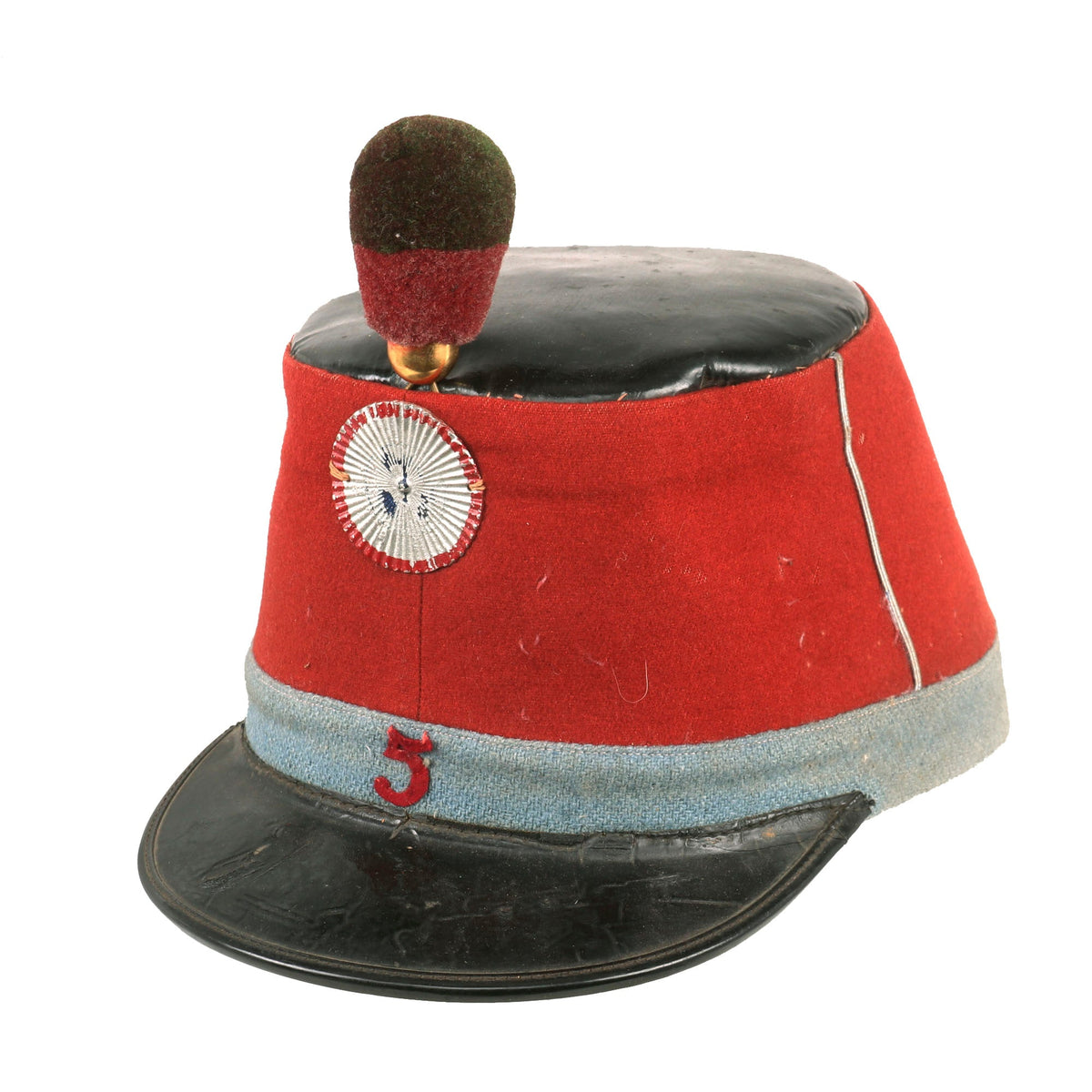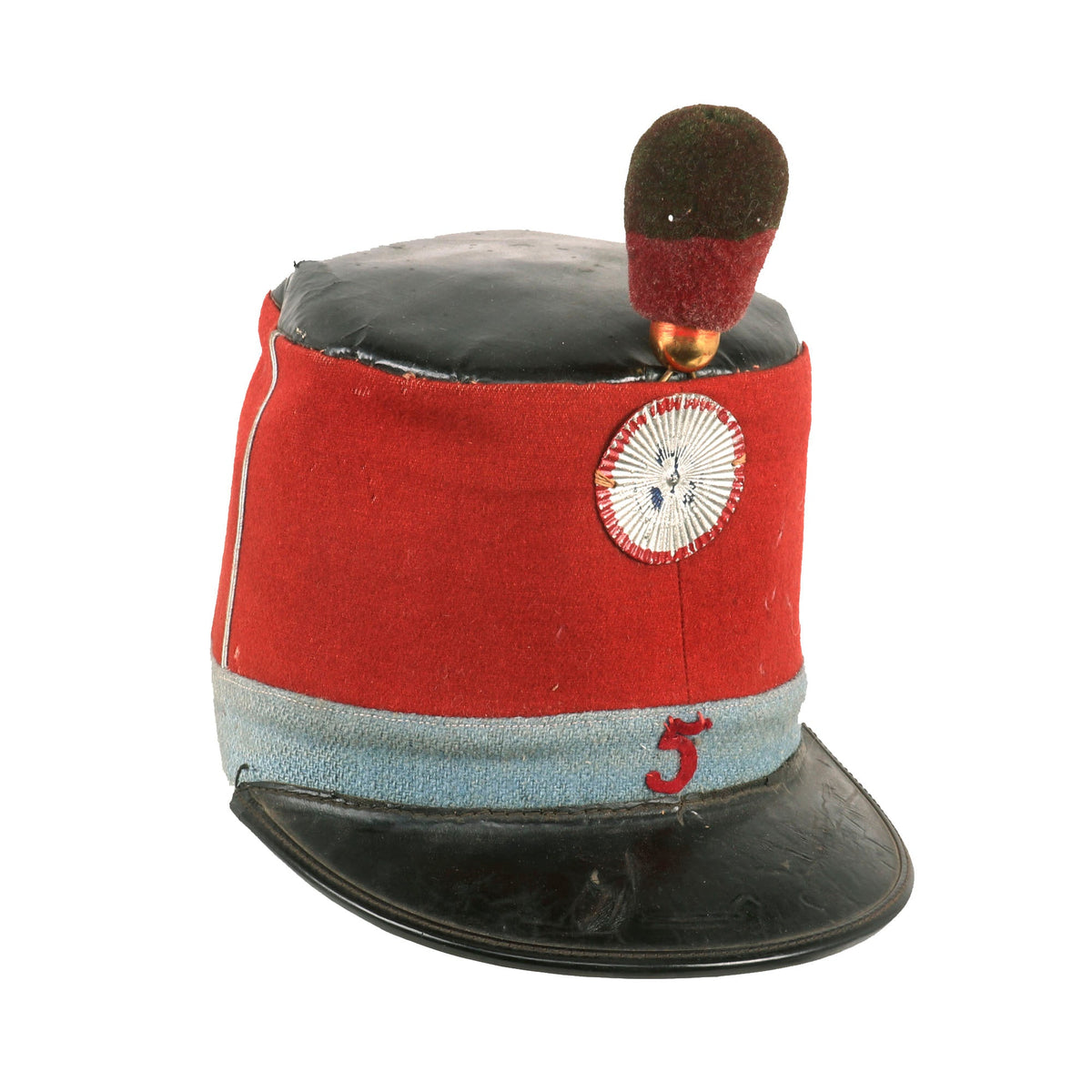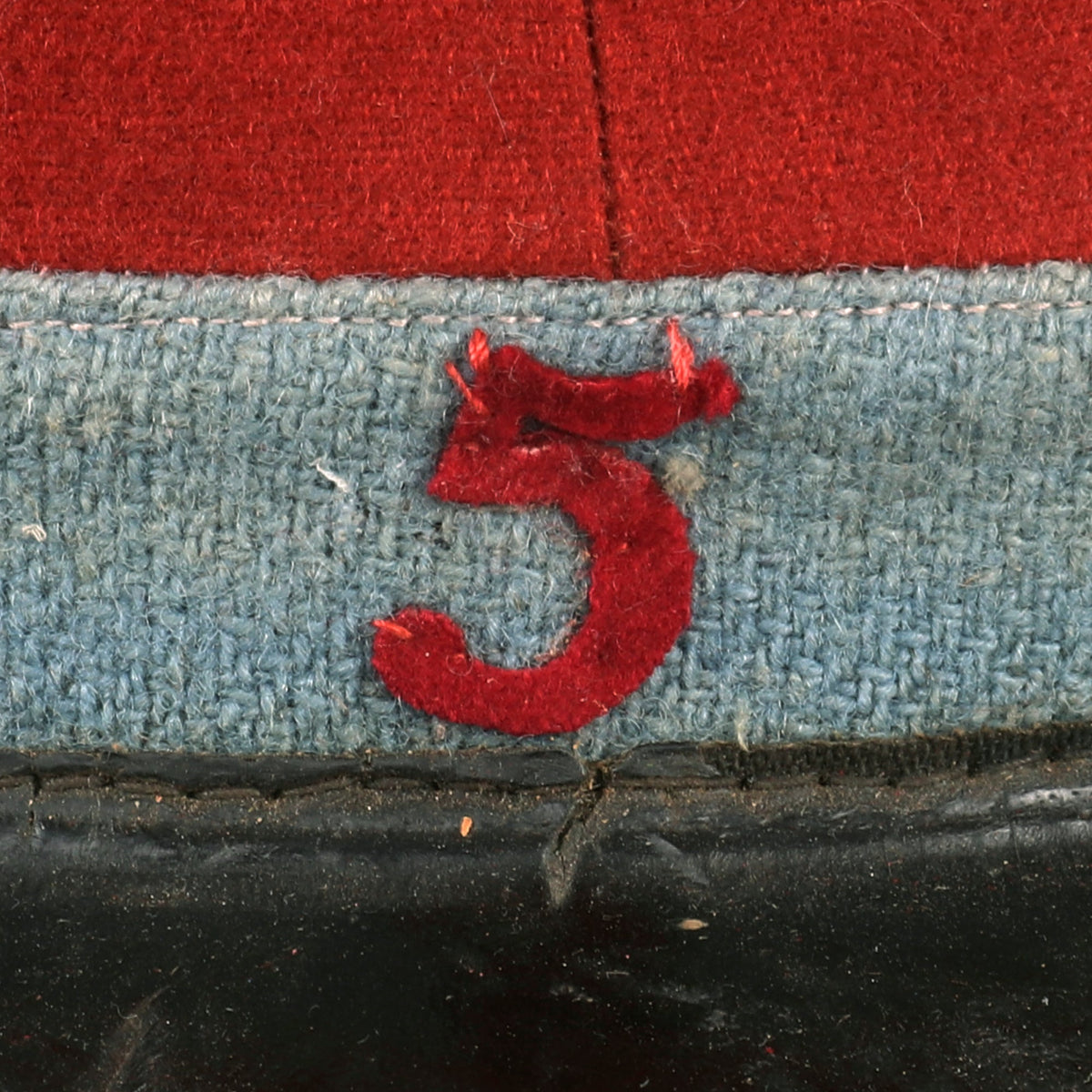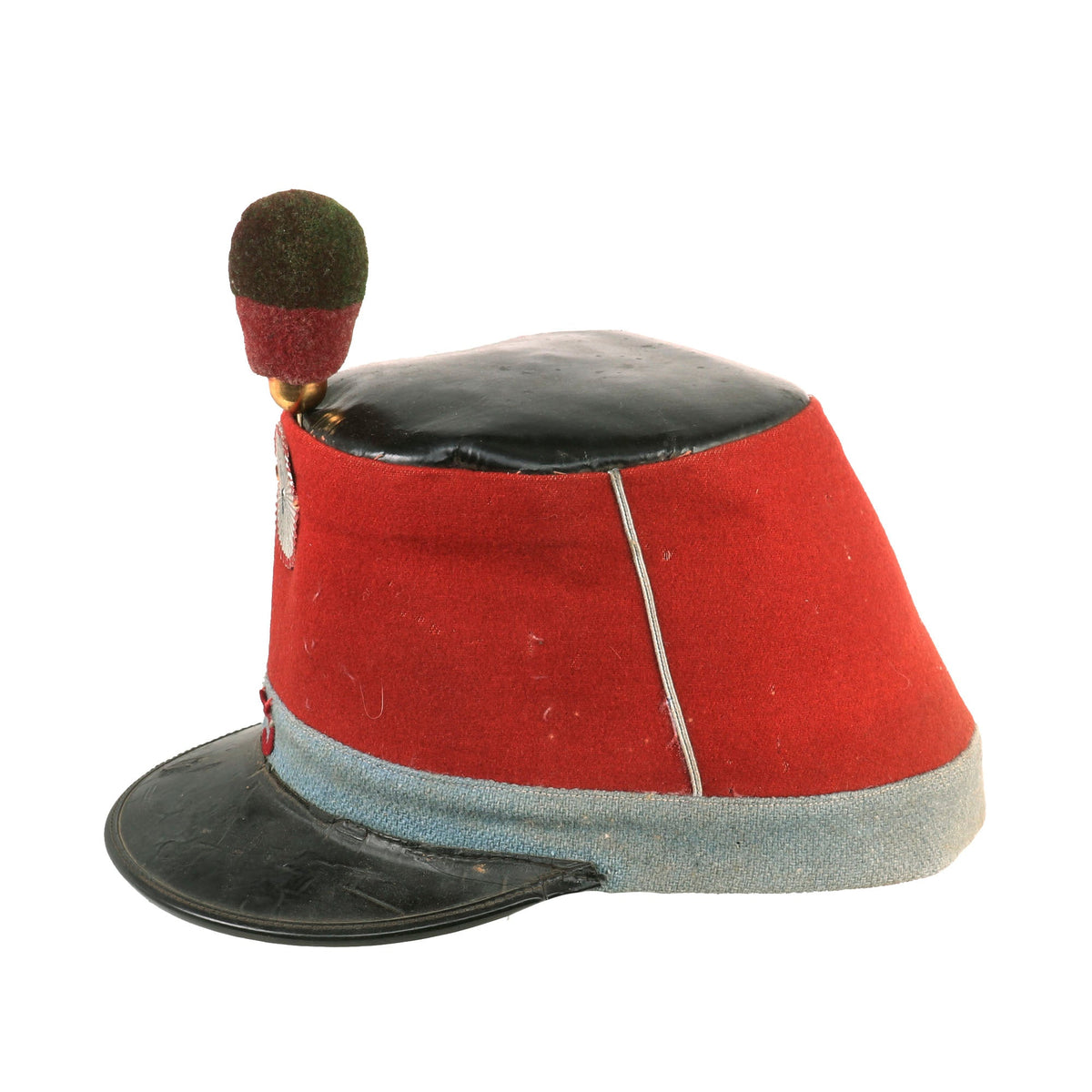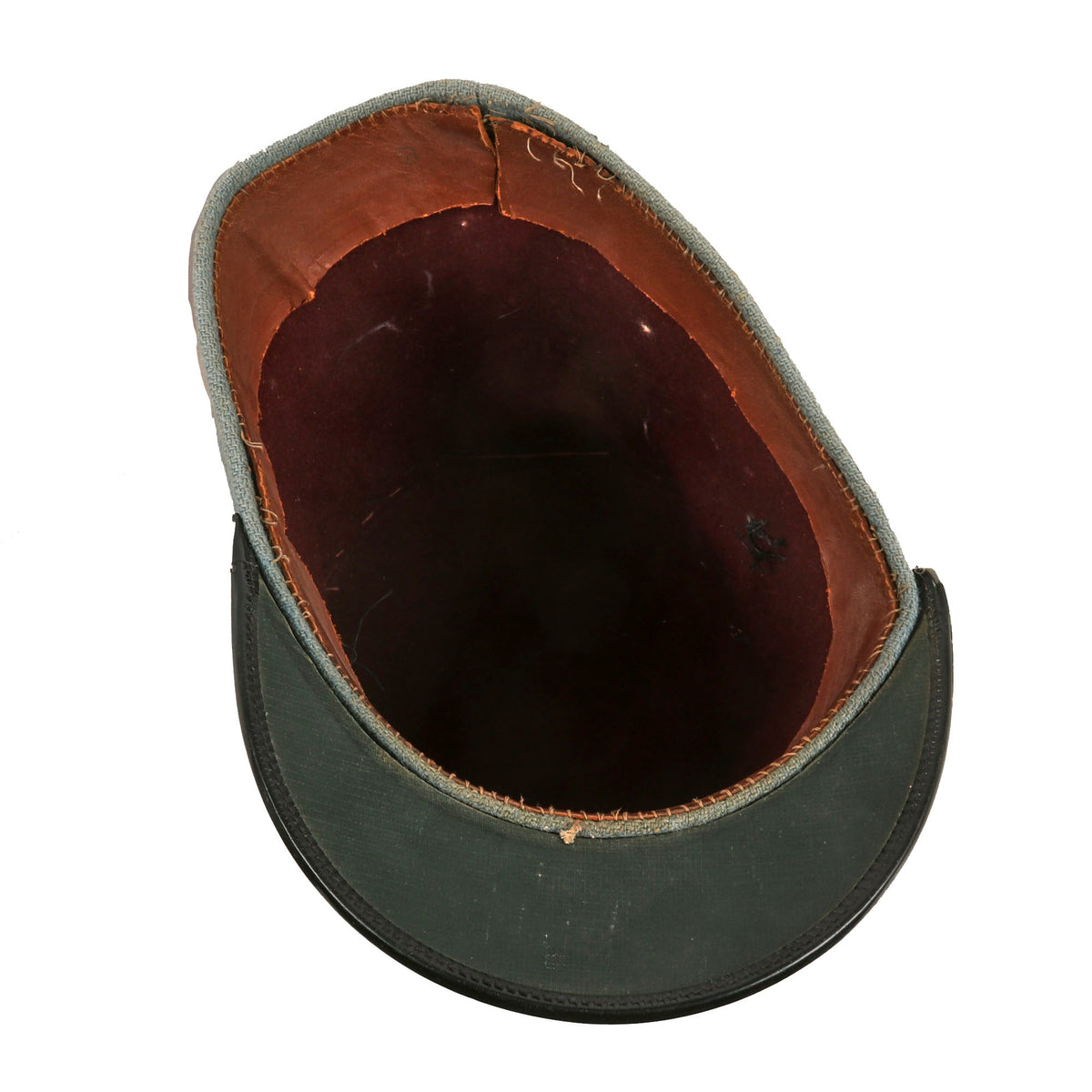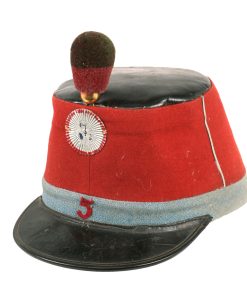Original French Franco Prussian War Era 2nd Empire Pattern 1852 5th Regiment Shako Képi Original Items
$ 495,00 $ 148,50
Original Item: Only One Available. The kepi is a military-styled headdress with a cylindrical form, a flat circular top, and a visor. It was commonly worn by the French Army but was also adopted by various other countries, including America.
In 1852, the first proper model of the kepi had a square visor. This slightly oversized visor was referred to as bec de canard (duckbill). This model had no chinstrap, but later designs had chinstraps, smaller visors, and buttons. This is an earlier variation, without a chinstrap or button, as well as a plume/pom-pom which was meant to identify the unit. This example is green & red. The shako also retains its tri-color cockade which is heavily worn. There is a small 5 stitched onto the blue felt indicating the 5th regiment.
By 1900, the kepi had become the standard headdress of most French army units. The kepis had different band colors, crown colors, braids, and logos for various units and ranks.
During the Civil War, Gen. George B McClennan preferred the kepi due to its French look, so it was also often referred to as the McClellan cap.’ Another alternative name to the kepi was the ‘chasseur-style cap.’
The best way to identify the Corps in which the Kepi belonged to is the colors. The color of the band on this example is Dark Blue, which has now faded to a light blue color. The color of the crown is red.
The condition is excellent for its age. The interior lining is hastily stitched in place and in lovely condition. The leather sweatband is still intact and stitched fairly. On the blue band, just below the French Horn is a red number 5, indicating a battalion. This may indicate the 5th bataillon de chasseurs à pied.
This Kepi comes more than ready to be researched and displayed!
By 1900, the kepi had become the standard headdress of most French army units. The kepis had different band colors, crown colors, braids, and logos for various units and ranks.
During the Civil War, Gen. George B McClennan preferred the kepi due to its French look, so it was also often referred to as the McClellan cap.’ Another alternative name to the kepi was the ‘chasseur-style cap.’
The best way to identify the Corps in which the Kepi belonged to is the colors. The color of the band on this example is Dark Blue, which has now faded to a light blue color. The color of the crown is red and this example has a Silver French Horn instead of a braid. Between the colors and insignia, this Kepi can now be identified as being used by Infantry Chasseurs or Chasseurs à pied.
The condition is excellent for its age, but does show the possibility of “recent” repairs or added items. The interior lining is hastily stitched in place and in lovely condition, but does have the possibility of being a much later addition, same with the chin straps. As mentioned above, the Pattern 1852 went through appearance changes and this could very well be the period added changes that were made. On the blue band, just below the French Horn is a red number 5, indicating a battalion. We believe this to be for the 5th bataillon de chasseurs à pied.
This Kepi comes more than ready to be researched and displayed!
The chasseurs à pied were the light infantrymen of the French Imperial army. They were armed the same as their counterparts in the regular line infantry (fusilier) battalions, but were trained to excel in marksmanship and in executing maneuvers at high speed. From 1840, they wore a long-skirted frock coat. After 1850, however the chasseurs adopted a uniform consisting of a short frock coat with slits in the sides on the bottom edge to allow for better freedom of movement than the previous design. They also wore light blue baggy trousers (in contrast to the red of the line infantry) tucked into jambières (leather gaiters).[4] The other light infantry unit type, the voltigeurs, specialized as skirmishers and for advance screening of the main force. The chasseurs could also be called upon to form advance guards and scouting parties alongside the voltigeurs.
Following the Napoleonic Wars the chasseurs à pied continued to exist as a separate corps within the infantry. Initially a specially trained elite, their tactical role eventually came to match that of the ordinary lignards (line infantry). By the late 19th century the differences between the two branches were confined to uniform and insignia, although the chasseurs retained a strong esprit de corps. Immediately after the Franco-Prussian War it was argued that the continued existence of an elite class of infantry that was armed and trained to the same standards as the ordinary soldier, was contrary to both military utility and the egalitarian principles of the new republic. However public opinion, influenced by the occasions on which the chasseurs had distinguished themselves during the war, was opposed to the disbanding of this distinctive corps. Under the Third Republic the chasseurs à pied were increased from 20 to 30 battalions. Of these, 4 saw active service in Tunisia, one in Indochina and one in Madagascar during the period 1880-1896. Twelve of the chasseur battalions were re-designated as mountain infantry (chasseurs alpins). The remaining chasseur battalions were deployed near the frontier with Germany as part of the troupes de couverture, charged with covering the bulk of the army during mobilization.
During World War I the French Army maintained 31 battalions of infantry chasseurs plus a varying number of reserve and territorial units. Each infantry division was expected to include at least one battalion of either chasseurs à pied or chasseurs alpine. Each battalion had an establishment of 1,300 to 1,500 men. They were reportedly nicknamed schwarze Teufel (black devils) by their German opponents, in reference to their dark colored uniforms. The chasseurs served mainly on the Western Front but detachments were sent to reinforce the Italian front in 1917.
Fast Shipping with Professional Packaging
Thanks to our longstanding association with UPS FedEx DHL, and other major international carriers, we are able to provide a range of shipping options. Our warehouse staff is expertly trained and will wrap your products according to our exact and precise specifications. Prior to shipping, your goods will be thoroughly examined and securely secured. We ship to thousands clients each day across multiple countries. This shows how we're dedicated to be the largest retailer on the internet. Warehouses and distribution centres can be located throughout Europe as well as the USA.
Note: Orders with more than one item will be assigned a processing date depending on the item.
Before shipping before shipping, we'll conduct a thorough inspection of the items you have ordered. Today, the majority of orders will be delivered within 48 hours. The delivery time will be between 3-7 days.
Returns
The stock is dynamic and we cannot completely manage it because multiple stakeholders are involved, including our factory and warehouse. So the actual stock may alter at any time. It's possible that you may not receive your order once the order has been made.
Our policy is valid for a period of 30 days. If you don't receive the product within 30 days, we are not able to issue a refund or an exchange.
You can only return an item if it is unused and in the same state as the day you received it. You must have the item in its original packaging.
Related products
Uncategorized
Uncategorized
Uncategorized
Uncategorized
Uncategorized
Uncategorized
Uncategorized
Uncategorized
Australian WWII Owen MK1 Machine Carbine SMG Custom Fabricated Replica with Sling Original Items
Uncategorized
Uncategorized
Uncategorized
Uncategorized
Uncategorized
Uncategorized
Uncategorized
Uncategorized
